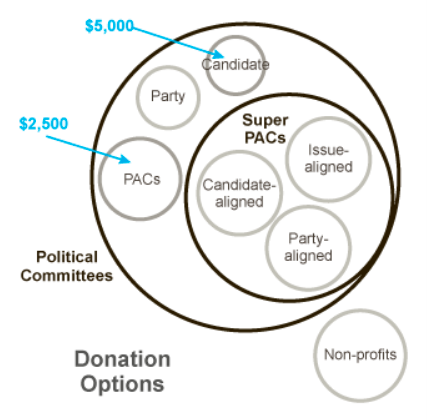A Roadmap for understanding campaign finance

|
This diagram is from a 2014 interactive article in the NYTimes. It is a great place to start understanding the effect of money in our politics. The limits on contributions are indexed to inflation, so the illustrated limits are now higher, e.g. $5400 can be given directly to a Candidate’s election committee ($2700 for the Primary and $2700 for the General election), and a conventional political action committee (PAC) can receive $5000 from an individual donor. |
The CMR PAC receipts for January 1,2017 to March 31, 2018

|
Dear Group, Orientation: We are still looking only at the political money in those three circles in the upper left of the diagram above. This is the money you can trace if you spend the time. This is the money BEFORE the Citizens United decision (i.e. SuperPACs) and it is money that is not “Dark” (i.e. money spent for political ends by non-profits with undisclosed donors–the little circle down and right). McMorris Rodgers, like all candidates, has her “for Congress” coffer, aka “Committee.”. By law money can only enter this coffer in relatively small chunks, $2700 per Election from an individual ($5400 per two year election cycle with a Primary and General Election) and $10,000 per cycle from a PAC. If stop looking after you’ve examined CATHY MCMORRIS RODGERS FOR CONGRESS (C00390476), though, you’ve only seen the tip of the iceberg. Among these three circles in the upper left part of the diagram is MCMORRIS RODGERS AMERICAN DREAM PROJECT; THE (C00543199). Here you get at hint of the big donors that keep an incumbent like McMorris Rodgers in office. Of course, this is merely a conduit used to squeeze money through the legal knotholes into the CMR for Congress coffer and the CMR PAC. Any excess of donations given to the “Dream” passes through to the National Republican Congressional Committee. Finally, there is the CMR POLITICAL ACTION COMMITTEE (C00469429), today’s topic. So far this cycle less money has sloshed through this one than the other two entities (600K vs. 2.7M vs. 2.1M), but it is still interesting. I urge you to click the link and explore. Contributions: Under “itemized individual contributions” of 100K we have only 36 contributors, only 16 from Washington State. (See the P.S. below for a closer look.) “Other committee contributions” of $369K is another laundry list of PACs, nearly all corporate PACs, 109 of them, nearly half in legal maximum per election packages of $5000 . Check it out here. The $148K under “Transfers from Affiliated Committees” all comes from 38 individuals (12 from WA), psss-throughs from the McMorris Rodgers American Dream Project. These must represent the ones who contributed to the “Dream” in excess of the $5400 that the “Dream” first sends to Cathy McMorris Rodgers for Congress. Is your head spinning yet? Expenditures: Where does the money go? $398K went as 163 contributions mostly to Republican candidates “For Congress” campaign committees. A few of those, unbelievably, went to yet other PACs, thus continuing the endless sloshing of the washtub of political money. Another $113K was spent under “Other federal operating expenditures.” The recipients: fundraising consulting firms (>$50K), legal fees (>$30K), food, hotels, and “compliance consulting.” Closing points: 1) With a bit of digging it is clear that large amounts of money from very wealthy corporate donors have attached themselves to McMorris Rodgers, many but not all from outside of Washington State. There are a few local notables. 2) Even within the small segment of campaign finance we’ve been examining (that is, NOT Super-PACs and NOT non-profits), even within this segment money is not easy to trace. The mega-wealthy can make contributions in so many ways that after the funds are washed (laundered?) and mixed through the traditional (non-Super) PAC system the money comes out gray. Indeed, much of our politics is fueled by “gray” money. 3) Remember that all the small contributions (<$200) make up only 1/3 of political contributions. Two thirds of political money is contributed in >$200 chunks. Those larger contributions are made by only 1 in 300 American adults in the midterm election cycle. (Only .04% of adults…1 in 2500…gives $2700 or more.) So who do we expect McMorris Rodgers to listen to? Keep to the high ground, Jerry P.S. Through their “Employees” (I think it is safe to say that in these cases “Employees”= substantial owners of), Inland Empire Paper Co. of Spokane and Nelson Irrigation Corp. of Walla Walla are major contributors to the CMR PAC (10K and 20K respectively, a total of 30% of the individual contributions to CMR PAC). You can explore other major monetary sprinklings of these contributors here and here. They total $60,400 and $40,800, respectively, just in this election cycle (1/1/17-present). P.P.S. Among the interesting contributors is one “Petrizzo, Thomas J.” listed for the purposes of the CMR PAC as a resident of Seattle, WA, occupation “Government Relations”, and “employed” by The Petrizzo Group, the D.C. lobbying firm Megan Perez joined recently after leaving McMorris Rodgers. You can explore his other 64 political donations here along with several different listed addresses. One of The Petrizzo Group’s clients, of course, is Omeros, the drug company for which McMorris Rodgers slipped in a nice perk via the Appropriations Bill. P.P.P.S. A cynical point: Is it an accident that all three of the McMorris Rodgers-linked campaign funds have different name labels: “Cathy McMorris Rodgers,” “McMorris Rodgers.” and “CMR?” Or was this intentionally done to discourage figuring it all out? There is no answer to this question, but there is reason to wonder. |